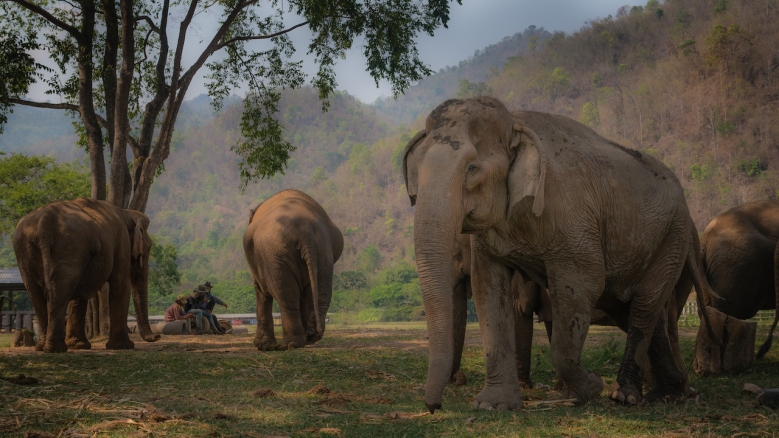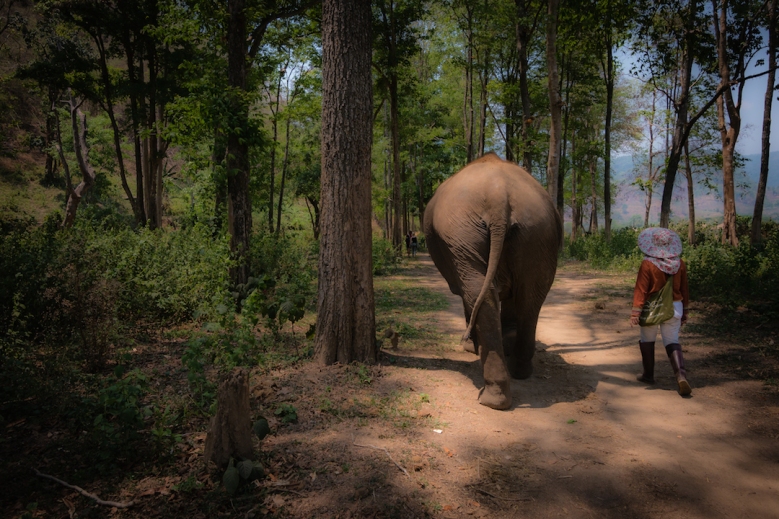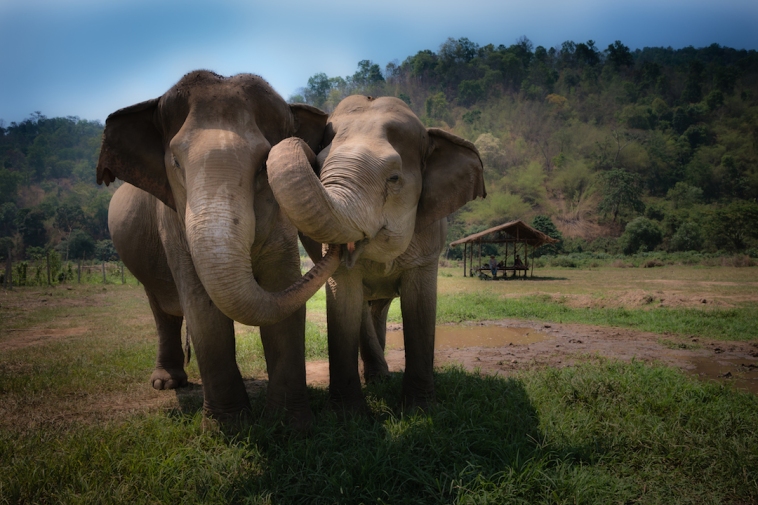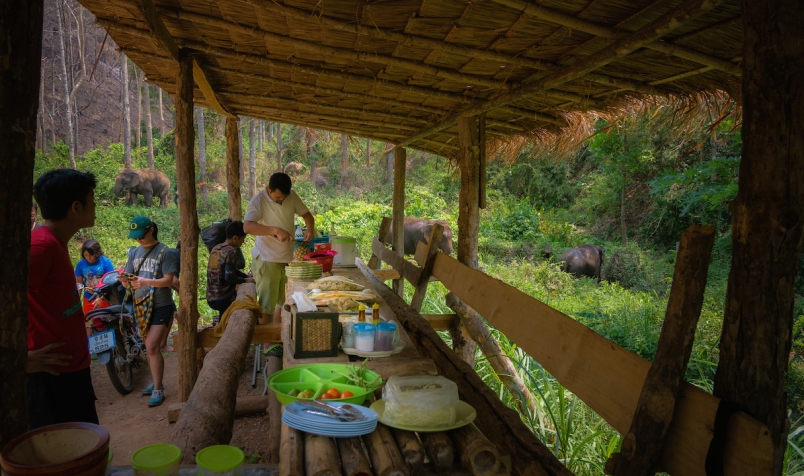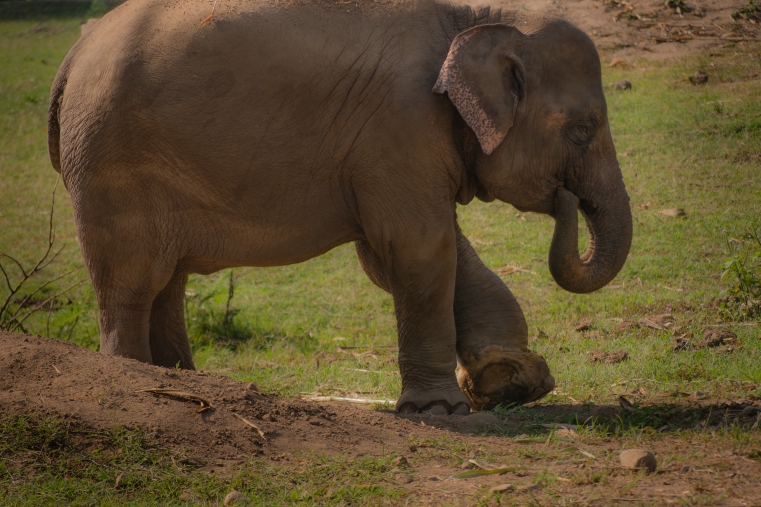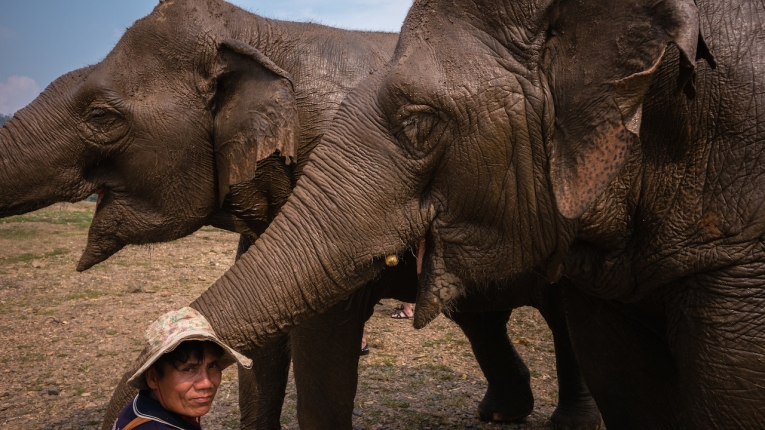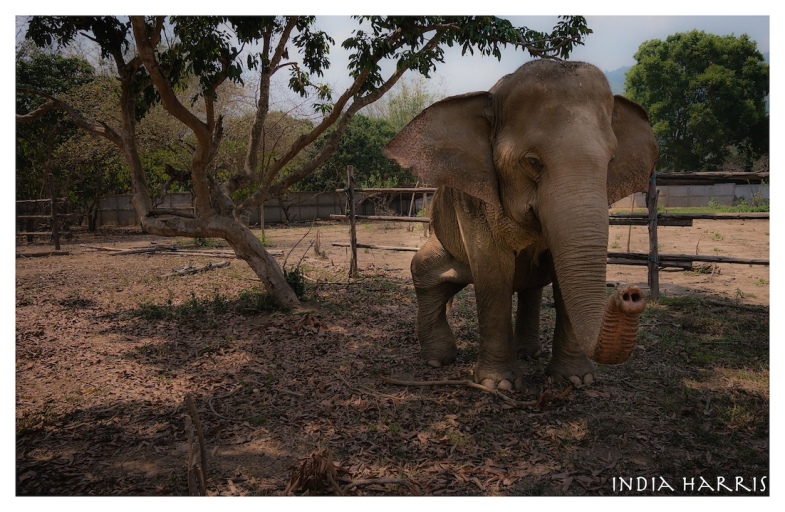
Apparently a mop is an exciting contraption if you are a kitten. For me, not so much. This morning our two adolescent cats followed me around the house in a state of rapt attention, their eyes glued to the mop in my hand. Though it may have been my imagination I thought I heard feline chuckling. Sadly, I am not nearly as skilled at the art of mopping as my larcenous ex-housekeeper.
Marie is the most recent in a long line of women who have stolen from me. The objects of their sticky fingers have included an LPG tank, cases of San Miguel beer, bags of sugar, two cameras, three lenses, a carbon-fiber tripod, wooden Balinese carvings, light bulbs, glass knickknacks, and a husband.
Yesterday, Marie lost her job because of a cheaply made, supposedly bronze statue, one of a pair that I bought in India two years ago. Perhaps the statue’s gold painted surface led her to believe that it was solid gold. Who can say? All I know is that I paid no more than $20 for it. Hardly worth losing one’s job over.
In every instance except Marie’s, I ignored the first few missing items, not wanting to face the uncomfortable task of firing a woman who has children to feed. But my cowardice only served to make each maid bolder and more ambitious, and in the end, created disaster for us all.
This was Marie’s first offense, but having learned some very expensive lessons, I fired her as soon as I discovered the theft. I have to admit that I always found Marie a little scary. I mean, she is a big boned, meaty woman whose dark eyes always made me think that she wouldn’t hesitate to take me down if ever I crossed her. So yesterday I was wary. In our conversation, I never actually accused her of taking the statue, though there is no doubt that it was she. I merely placed its matching partner on the dining table and said that one of these statues was missing so I had decided not to have anyone working inside my house anymore. I pulled out some cash and handed it to her, a very generous amount of severance pay considering that she had stolen from ME. And she walked away looking fairly pleased with the whole situation.
But then I wondered, why does this keep happening to me? The same situation keeps repeating itself over and over. Does this mean that I am creating it? And if so, why would I do this? When I thought about it for a while I realized that I have a belief that all maids steal after a certain amount of time. Is it possible that my BELIEF that all maids eventually steal is what turns otherwise honest women into thieves? Or do I believe it because it’s actually true? Or, maybe what goes on inside my head has no bearing on anything whatsoever.
Undeniably, the power of suggestion is strong. Have you ever been on a public bus that has no toilet when the driver has commented that it’s going to be three hours until the next bathroom stop — and your bladder has instantly filled?
Might our beliefs about other people have a similar effect on them? It wasn’t all that long ago that I was looking at the two-year-old son of a neighbor and thought to myself, you poor kid, you haven’t got a chance in hell. Why did I think such terrible thoughts about this little kid? My rational mind will answer that he comes from a long line of gamblers and deadbeats so he’s doomed — but so what? Anything and everything is possible. Maybe our thoughts and beliefs somehow get out there into the ether and actually influence people and I have done that child a big disservice.
I have no idea if there is merit to any of these ideas, and who could possibly say for sure, anyway. But eventually, when I replace Marie, I am going to be very careful with my thoughts!
India

The silverback hesitated, watching us intently from behind a screen of foliage. He then seemed to make a decision and began moving toward us quickly. His size was intimidating, roughly 450 pounds we had been told by our guide. Trust me, that’s BIG when you’re up close. Our rules had been clear: maintain a minimum distance of seven meters from the gorillas. This big silverback didn’t seem to care about the rules. He was within touching distance. I held my breath and stopped shooting photos. What was he going to do? In the end, he sat down near our group and just hung out. The rest of his family was nearby, playing with the baby and grooming one another. It was a special moment.
The last remaining mountain gorillas live in Uganda, Rwanda and the Democratic Republic of Congo. Fortunately, their numbers have been increasing steadily, after being nearly decimated in the 1970’s. Now they survive because they are tourist attractions, generating roughly $20 million annually. Let me stress this — if it were not for tourists, the future would be extremely bleak for the mountain gorilla. The human populations of Uganda and Rwanda are among the densest in the entire world. It’s common to have ten or more children and there appears to be no end in sight for the rapid growth. As a result, the need for more and more farmland has become increasingly important and de-forestation is rampant. Unfortunately, mountain gorillas live in the forest.
The wildlife authorities have been clever, however. They charge tourists large fees for spending one hour with a gorilla family (Rwanda charges $750 per visit, Uganda charges $600 and the DRC charges $465) and much of this money goes into community projects such as schools and health care and the local people can earn much needed extra income as porters and tracking guides for tourists. Basically, the community now views gorillas as something good in their lives. “If it pays, it stays”. The gorillas are used to us and don’t seem to mind the one hour per day their lives are intruded upon. Maybe they understand that their lives depend on this one hour of viewing per day…
Happily, because of this symbiotic relationship, gorilla poaching has becoming virtually nonexistent. Can you guess what gorillas used to be poached for? It’s hard to believe that, aside from bush meat, the primary use for gorillas was to make ashtrays from their hands. Sometimes I am truly ashamed to be human…
There are lots and lots of babies among these family groups, I’m happy to report. Their future growth will only be limited by the amount of forest that has been cut down for farming. Basically, the mountain gorilla will survive if we humans want them to.
I cannot describe how much I enjoyed my experience spending time and photographing four different gorilla families in Uganda and Rwanda. I hope you enjoy the photos and I particularly hope that you will get out there and see these magnificent beings for yourself one day.
India

I’m not sure why, but it seems that I have only enough creative energy to do either writing OR photography — but not both at the same time. It’s a little frustrating, actually. When I get the urge to write, my camera gathers dust — and when I’m running around with my camera, I seem incapable of writing a single sentence. My camera has been very busy recently, and I’ve just returned from an absolutely incredible trip to Iceland. I had wanted to visit this remote island settled by Vikings for a long time — and it was everything I had hoped for. Next time I’ll go in winter to see these wild and rugged landscapes covered in snow and ice.
Here are a few pics that I hope you’ll enjoy…
India

Two months ago I swam with dolphins in Hawaii. They were not wild dolphins, but had been born in captivity, or as our dolphin trainer politely corrected me, they had been “born under human care”. Apparently, the word “captivity” evokes more negative images than “under human care.” But her comment made me wonder — is human care really such a good thing? Do we humans actually take good care of anything, including ourselves?
My dolphin swimming experience (which was wonderful, by the way) was shared with two other people, a 40-something Canadian woman and her teenaged son. The woman explained that she had dreamed of doing this since she was a child, when she first saw dolphins swimming in the Atlantic, more than forty years ago. Today was the big day.
The trainer explained that the dolphins were allowed to do what they wanted. They would not be forced to do anything against their will. And only positive reinforcement would be used. If the dolphin rolled over when the trainer asked, the dolphin would receive several fish and lots of verbal praise. On the other hand, if the trainer asked the dolphin to roll over and the dolphin swam away, there would be no yummy fish treats and no cheering or verbal praise. The important thing was that there would be no punishment, no scolding and no raised voices. It was all about having fun.
Dolphins LOVE to have fun. They zoom through the water, chasing each other above and below the surface. They leap and spin and squeak and play some more. You can’t help but laugh when you’re around dolphins.
And that’s when I had a sad epiphany. We humans have almost forgotten how to have fun. When the trainer asked the teenaged boy if he wanted to kiss the dolphin, the boy looked embarrassed and said no. The mother seemed quiet and very subdued. Given that she had dreamed of this day for more than forty years, I was surprised at how reserved she was around the animals. Was she frightened of the dolphins? Had she forgotten how to play?
After our 30-minute session ended, the next group being prepared for their swim included a woman wearing a thick layer of make-up. No, she didn’t want to get her face wet, wasn’t going to wear a mask or dive with the dolphin. Her mascara might run. Sorry…
For the rest of the day, as I wandered around Waikiki, I observed parents with their children, wondering exactly how beneficial it is to be “born under human care”. And do we practice positive reinforcement with our own offspring?
What I observed can be summed up in one word: “NO”! We are a shockingly negative animal. Over and over, children were being told, “Don’t do that!”, “Not now, maybe later”, “Be quiet”, “Stop that!”, “Put that down”, “I told you not to do that”. No, No, No…
Watching these families on vacation made me feel depressed. What the hell are we doing to kids?! When we begin our lives we’re so full of curiosity and energy. And dreams. But it seems that kids aren’t allowed to play for very long in our culture. Hey, it’s a dangerous world out there, kids need to learn to follow the rules, and let’s not forget how competitive life has gotten. If we want our kids to get into the best colleges, they’d better start off in the right pre-schools. No time to waste. Everyone’s busy getting ready for… Hmm, what exactly are we getting ready for?
All this makes me wonder if most humans even know the difference between captivity and freedom — since we ourselves are so accepting of the limited amount of liberty that we experience in our own daily lives.
We could learn a lot from dolphins…
India

I came to Thailand to buy an elephant. Not to own one as a pet so I can tie it up in my backyard and impress the neighbors — but to buy freedom for a working elephant. This has been my goal for quite a while. Six years ago I came here and worked as a volunteer at an elephant sanctuary called Elephant Nature Park outside of Chiang Mai. At the risk of sounding like a cliche, I will say that the experience changed my life.
The future of elephants in Thailand looks pretty bleak right now, but there is definitely a ray of hope. An entire book could be written about the plight of the Asian elephant, but here is a very quick summary of the situation. Let’s get the bad stuff out of the way first (and I’m not going to show pictures of the bad stuff. We all see way too many gory photos. I want this to be a story about hope and optimism). A hundred years ago there were approximately 100,000 elephants in Thailand. Now there are an estimated 5,000 remaining, only half of those still living in the wild. In Thailand domestic elephants have the same legal status as livestock. They have no more rights than a cow or a pig or a chicken. Elephants work hard, many hauling heavy logs in remote, mountainous areas — even though the government banned logging in 1989.
Other elephants work on the streets of busy cities like Bangkok or Chiang Mai, begging tourists for money. The elephants earn a lot of money for their owners this way, but you can imagine how stressful it is for an elephant to live in a crowded, noisy city, dodging cars, buses and motorbikes, breathing in exhaust fumes night and day.
Many elephants work in the tourist industry, giving tourists rides on their backs along jungle trails, or even painting pictures. Elephants are quite talented. And though this kind of work seems harmless enough, it’s tough on the elephants. They lose their families and are taken from their mothers at a very young age. Just as horses are “broken”, elephants must also lose their wild spirits to become submissive to their human masters. The intensity of this “breaking” literally kills many. And though there are many good, responsible tourist camps, there are some very bad ones. Elephants are sometimes chained up in stables for long periods of time, underfed and neglected. It’s a sad situation for such a gentle, intelligent, beautiful animal.
But like I said, there’s a ray of hope. A Thai woman named Lek Chailert, has devoted her entire life to improving the situation for the Asian elephant. You could call Lek an “elephant whisperer”. She can look into their eyes and communicate with them. Twelve years ago she created a sanctuary in a remote valley in northern Thailand and named it Elephant Nature Park. The park is now home to forty-four very happy elephants, which are now in “retirement”. I’ve just spent the past four incredible days there and I’ve never seen so many happy elephants. And cats and dogs and water buffalo and ducks and cows. It’s like Old MacDonald’s Farm. Elephant Nature Park takes in any animal who needs rescuing — even animals that jumped off the truck heading to the slaughterhouse!
Lek Chailert believes that elephants can be trained using positive reinforcement rather than the traditional system of beating the animal into submission. There have been elephants born at the Park, and she is able to show live proof that her system can work. She also believes that with education, the next generation of Thais will take better care of the environment and will understand that ecotourism can make just as much money as traditional elephant trekking.
Elephant Nature Park offers ecotourism programs. You can spend a whole day walking with elephants, feeding them, interacting with them, having fun with them. But you don’t ride them. Trust me, it’s wonderful. You can stay overnight at the Park and spend even more time with the elephants, including bathing them in the river which runs through the Park. Even celebrities like this place. Two that come to mind that have visited are Meg Ryan and Owen Wilson.
There are several different volunteer programs, including a dog volunteer program for those who love dogs. As you can imagine, it costs a huge amount of money to feed forty-four elephants and hundreds of other animals as well. Every dog, every cat and every elephant I saw has a round belly, and everyone receives excellent veterinary care. Ecotourism, voluntourism and donations pay the bills. The success of Elephant Nature Park has not gone unnoticed. Trekking camps have begun to take an interest in ecotourism as well. Personally, I think that walking beside an elephant is much more fun than sitting on top in a saddle. At one point during our walk, an elephant wrapped her trunk around my waist, hoping to find bananas in the fruit bag we were each given at the start of the day.
There are many young, healthy elephants in the Park, but many are elderly and have various handicaps. Here are some of the elephants whose stories will touch your heart. They are all living very happily now, with nothing to do but eat, sleep and play — and heal. They are treated with love, respect and kindness.
This is a young male wild elephant whose leg was caught in a snare. He was brought to the Park for veterinary care and his foot is slowly healing, though it will never be normal again.
This is a land mine victim, but she lives happily with her adopted family.
This is Jokia, who is 54 years old and completely blind in both eyes. Jokia was pregnant when she started a new job in a logging camp. She gave birth while pulling a heavy log up a hill. The newborn rolled down the hill and died, still in the placenta. Jokia was not allowed to go to her baby and responded by refusing to work. Her mahout hit her eye with a slingshot, blinding it. Later, she swung at the mahout with her trunk, injuring him. He blinded her second eye. Lek bought Jokia for $2000 and brought her to the park in 2001 where she became best friends with Mae Perm, on the left. The two elephants are inseparable, Mae Perm leading Jokia around, understanding that Jokia cannot see.
This is Medo, who is 39 years old and has been at the Park since 2006. It’s heartbreaking to watch Medo walk, but she is free now and no longer forced to drag logs all day long. She has friends and is a happy elephant.

Photo by Elephant Nature Park. Medo’s hip and back injuries were never treated by her previous owners.
This is Sook Sai, 51 years old. She only recently arrived at the Park, in January of this year. Sook Sai broke her ankle carrying tourists and when it healed, she limped. Many tourists complained about the bumpy ride they got from riding on Sook Sai, so she was sent out to beg in the streets. More tourists complained that it was cruel for this limping elephant to be walking on busy streets so her owners put Sook Sai into a forced breeding program. Not much is known about this period of her life. But when Sook Sai came to Lek’s attention, she was chained up and left to stand in her feces, often going without food and water. Now she has retired!
It’s funny how we can go somewhere hoping to do one thing and yet something completely unexpected may happen. I went to Elephant Nature Park thinking that I could help an elephant. But of course, the elephants helped me. I laughed and I played and felt completely alive. Their incredible spirits are an inspiration for us all. This is a place to come for healing, especially if you volunteer and can spend at least a week among these special animals.
I know how it feels to be “unfree” and I know how good it feels to lose those chains. So yes, I will donate money to rescue another elephant for the Park when the opportunity arises. I can’t think of a more worthy purpose in life.
For those of you who are interested in visiting this magical place, you can find more details at http://www.elephantnaturepark.org.
India
(all photo credits – India Harris except the ones with me in them!)

Wow, lots of you guys are dog lovers!! I’ve had so many messages during the past month asking how Private Ryan is doing and I thank you for caring about a dog that one Englishman in my neighborhood recently told me “needs a bullet”. Well, the answer is:
Private Ryan has developed a small belly during the past month! He also has much more energy than he used to have, but his skin and fur remain a disaster — which is an indication that his overall health is still not good. On the bright side, there is definitely some new fur beginning to grow in. I’m still not sure how well Private Ryan will fare in the long run, but I do know that he has not experienced hunger in the past month.
When I first began feeding this dog that looked like a skeleton, I had no idea that I would end up learning so many things. Such as:
1. You can’t just feed one hungry dog. Three of Private Ryan’s “mates” now show up for meals as well. So I’m kind of running a doggy food bank these days. But that’s okay. (You can see his mates in the cover photo)
2. Private Ryan is becoming fussy, sometimes picking through his bowl to eat the meat, leaving rice behind. But that’s okay because whatever Private Ryan doesn’t eat, one of his mates will.
3. Private Ryan has a mean side. He often growls and bares his teeth in a threatening manner at his hungry mates as they are eating from their own bowls.
4. Well fed dogs are horny dogs. A few nights ago I went to our front gate around 11:00 let in our dog, Mustang. Who did I see outside, but Private Ryan, strutting along the street, sniffing at the rear end of a female dog. So there may be junior Private Ryans in a few weeks. Which is a problem. These dogs need to be spayed and neutered — which I’ll look into the possibility of having done, though THAT is much easier said than done where we live.
5. Private Ryan will not let me take a photo of his face. Whenever he sees the camera he bolts, suggesting that he thinks the camera is a rock — and all dogs in the Philippines routinely have rocks thrown at them.
6. Dogs show gratitude, if not with words, with their eyes and body language. I hadn’t expected that I would make so many new four-legged friends.
7. My Filipino neighbors are pleased that I am feeding the dogs. With a couple of exceptions, most of my white neighbors act like I am stupid and/or crazy to be feeding the dogs.
8. I’ve learned that I don’t give a hoot what anybody thinks. I’ll do what I think is right.
9. I’ve learned that there is indeed pleasure in giving and helping.
10. One of my biggest criticisms of TV news is the way it bombards us with terrible stories which we the viewers are completely helpless to do anything about. The sense of hopelessness this creates is definitely unhealthy. So I think it’s great to see a local problem and be able to physically get out there and do something to fix it. Which is why volunteer work helps both the recipient AND the volunteer. And so I thank Private Ryan for the lessons he has taught me and for the opportunity to give back.
The doggy food bank will remain open for four-legged diners as long as there is a demand for it. And I thank you, dear readers, for caring about Private Ryan. I’m quite sure that your well wishes have made a difference.
India

Yesterday I experienced a coincidence which I have since decided was “a sign”. Yesterday was the anniversary of my Aunt Bonnie’s death from cancer six years ago, a date which is probably remembered by almost every member of my family. Though I have hundreds of wonderful memories of Aunt Bonnie while she was alive, I have to admit that when I am reminded of her now I mostly think about her tombstone and the lesson it has taught me.
You see, Aunt Bonnie had a dream of swimming with dolphins. She really, really wanted to swim with dolphins. But she never got around to doing it. I’m not sure why not. Maybe she was too busy or thought it was too expensive or figured she’d do it the next year. But it turned out there wasn’t a next year for Aunt Bonnie. And so she never got to swim with those dolphins. In the end, my uncle had dolphins engraved on her tombstone. What else could he do? Anyway, this whole tombstone story has left a huge impression on me: swim with the damned dolphins while you can! I realize that not everyone wants to literally swim with dolphins — but don’t we all have our equivalent of a dolphin dream?
So here’s where the weird coincidence comes in. Yesterday I decided to unpack Moving Box #32, which has remained all taped up and sitting on our bedroom floor since we moved last October (it’s a good thing I don’t move very often — I’m terrible at it). Inside, I found one of those little treasures that makes unpacking almost exciting: a notebook from when I lived in Tokyo, dated 1993. A time capsule!
I learned a few things about my life in 1993:
1) I was very concerned about money. The pages are filled with calculations and estimates for my savings account.
2) I ordered a lot of clothes from the U.S. because I couldn’t find any to fit me in Japan.
3) I was obsessed with traveling. I wanted to go to Tahiti and New Zealand and India and Antarctica and Mexico. And guess what else I wanted to do, back in 1993? I wanted to go to Hawaii and swim with dolphins….
How could I have forgotten this? In the years since I scribbled in that notebook I HAVE been to Tahiti and New Zealand and India and Antarctica and Mexico. I even lived in Hawaii for a year but I never thought about swimming with dolphins! I cannot remember even thinking about a dolphin. Well, it just so happens that I am scheduled to fly to Hawaii on March 3rd, just a few days from now — though I had no plans to swim with dolphins — until yesterday, when I found that notebook and remembered Aunt Bonnie’s tombstone on the anniversary of her death. So thank you, Aunt Bonnie, for that gentle reminder…
At 2 p.m. on Monday, March 16th, I will be swimming with dolphins in Honolulu. I’ll let you know how it feels…
India

He’s not much to look at right now and maybe he never will be. The fact is, he may not live through the week. But then again, he might. I’ve named him Private Ryan because he’s in a battle to survive and he definitely needs saving. Private Ryan lives in my neighborhood, though in an area where I rarely travel. I saw him last week and was horrified and angry. “Oh, you mean The Walking Dead”, said my animal-loving English landlord when I asked him about the skeleton dog that wears a green water hose for a collar. This should not happen, I thought.
Since that time I’ve fed Private Ryan two big hot meals a day and will continue to do so indefinitely. My Filipino neighbors seem happy that I’m taking care of him. No one enjoys looking at this level of suffering. “His owner only gave him shrimp heads”, said one woman. “That’s no good”.
These photos were taken this morning, and believe it or not, he’s come a long way in a week. I can no longer see his entire rib cage. I’m hoping that his fur will grow back normally now that he’s recovering from malnutrition and starvation. His sores seem to be healing. Last week he spent all his time curled up in a garage, on the tiny piece of cardboard which is his bed. Now he is up and about, spending his days outside. He seems to know that he’s won the lottery. He recognizes me and comes trotting toward me as I deliver his food bowl.
Who cares about one hungry dog when there are so many thousands of others all over the Philippines? I don’t believe in throwing up my hands and crying and moaning that it’s hopeless because I can’t save the world. Nobody is asking me to save the world. Of course, I can’t. But I can save Private Ryan. Maybe. I’d say he’s got a 60/40 chance of making it. But last week he had ZERO chance. And it matters a lot to Private Ryan. I also don’t believe in strutting around pompously, pointing my finger at poor, uneducated people and telling them how it’s “done” in England or America or Germany. I see foreigners doing that all the time and it makes me ashamed of my race. I will take responsibility for this dog and make sure that he has what he needs — which is better than talk or tears or pointed fingers…
We’ll see how it goes for Private Ryan. I’ll give you an update at the beginning of March. It may be bad news, of course, I can’t tell yet. But he may be doing great. Let’s keep our fingers crossed.
Just because you can’t save the world, doesn’t mean you should bury your head in the sand. We can all do our bit. It matters.
India
































